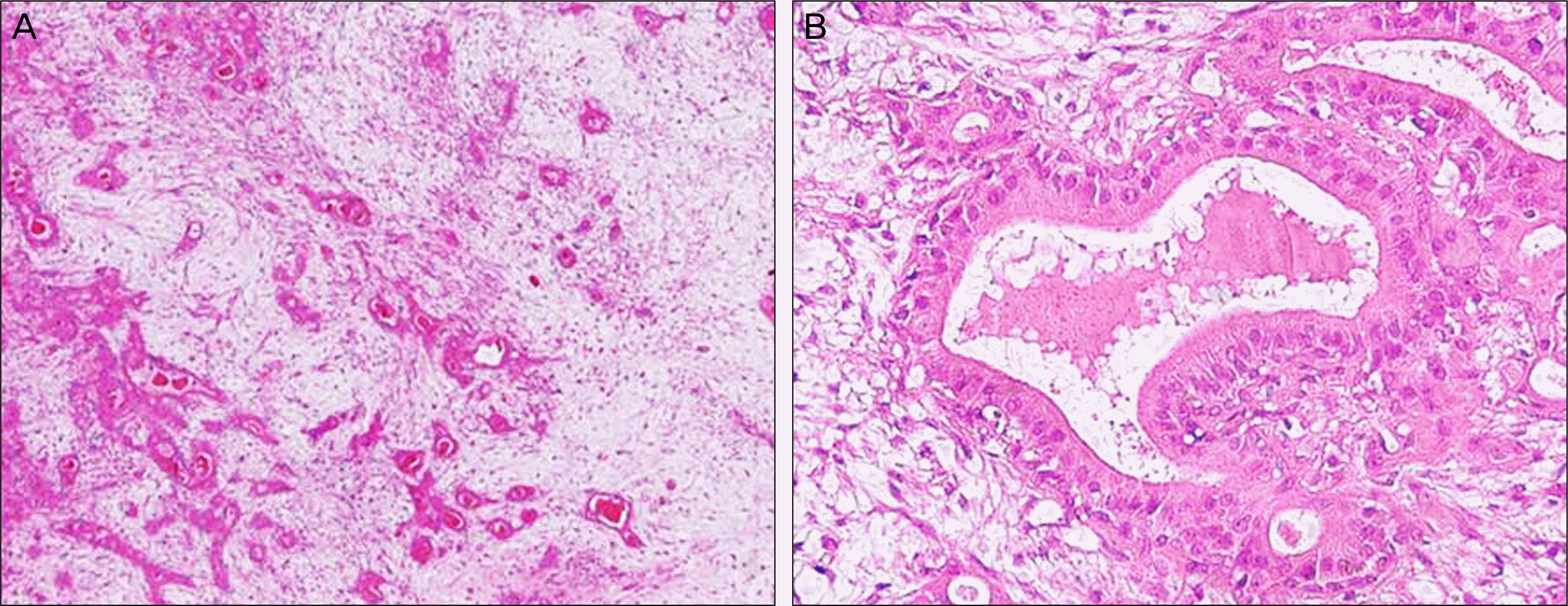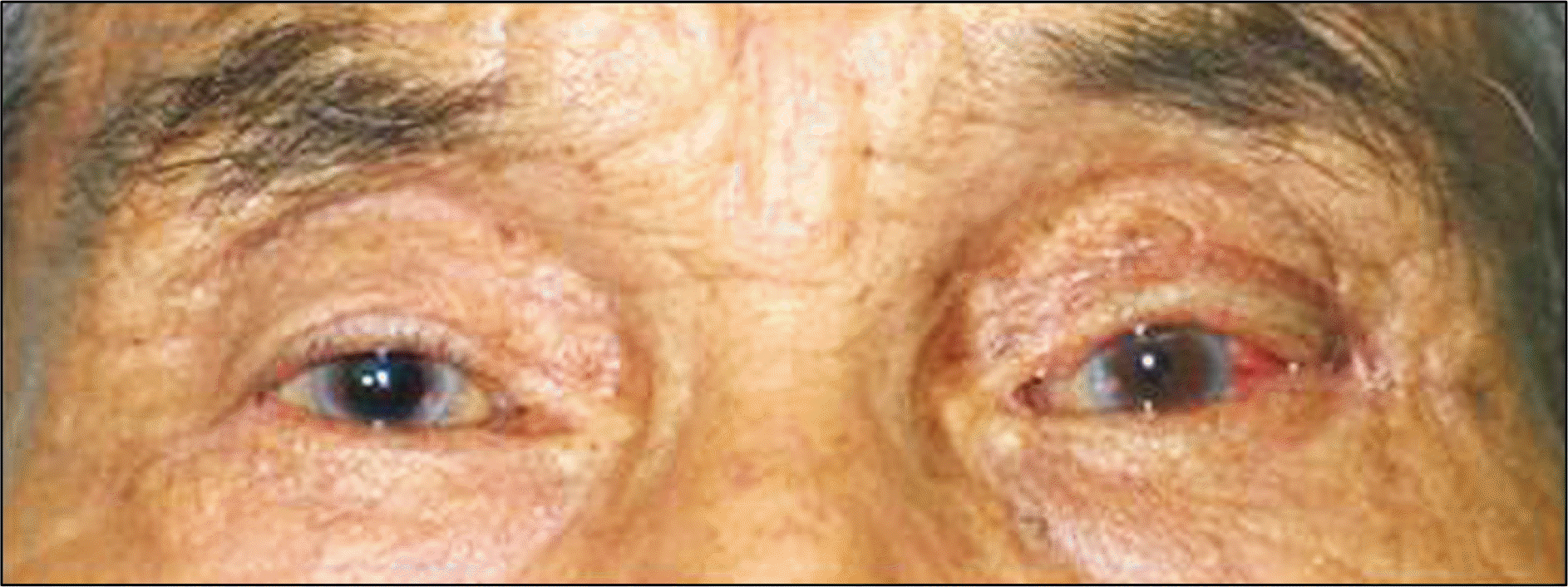Abstract
Purpose
To report a rare case of giant pleomorphic adenoma of the lacrimal gland involving the palpebral lobe causing severe mechanical ptosis and visual field defect, which was removed successfully.
Case Summary
An 82-year-old man visited our clinic with a large protruding mass on his left upper lid that had grown for approximately 10 years causing severe ptosis. Preoperative orbital CT showed a 2.3 × 2.0 cm sized large mass which was suspicious of hemangioma. The mass was completely excised through a lid crease incision. The histopathologic examination showed typical findings of pleomorphic adenoma. After the surgery, preoperative mechanical ptosis was completely resolved and during the 6 months of followup, there was no abnormality of tear secretion and evidence of tumor recurrence.
References
1. Shields JA, Shields CL, Scartozzi R. Survey of 1264 patients with orbital tumors and simulating lesions: The 2002 Montgomery Lecture, part 1. Ophthalmology. 2004; 111:997–1008.
2. Albert DM, Jakobiec FA. Principle and practice of ophthalmology. 1st ed.Philadelphia: W.B. Saunder company;1994. p. 1952–6.
3. Murphy MB, Rodrigues MM. Benign mixed tumor of the (palpebral) lacrimal gland presenting as a nodular eyelid lesion. Am J Ophthalmol. 1974; 77:108–11.

4. Auran J, Jakobiec FA, Krebs W. Benign mixed tumor of the palpebral lobe of the lacrimal gland. Clinical diagnosis and appropriate surgical management. Ophthalmology. 1988; 95:90–9.
5. Shields CL, Shields JA, Eagle RC, Rathmell JP. Clinicopathologic review of 142 cases of lacrimal gland lesions. Ophthalmology. 1989; 96:431–5.

6. Mindlin A, Lamberts D, Barsky D. Mixed lacrimal gland tumor arising from ectopic lacrimal gland tissue in the orbit. J Pediatr Ophthalmol. 1977; 14:44–7.

7. Mueller EC, Borit A. Aberrant lacrimal gland and pleomorphic adenoma within the muscle cone. Ann Ophthalmol. 1979; 11:661–3.
8. Kim NJ, Choung HK, Khwarg SI. Benign mixed tumor arising from an accessory lacrimal gland in the inferior palpebral conjunctiva. J Korean Ophthalmol Soc. 2006; 47:1673–7.
9. Shin KS, Kim YD, Lee HK. A case of benign mixed tumor presenting as a nodular eyelid lesion. J Korean Ophthalmol Soc. 1991; 32:101–5.
10. Wright JE, Stewart WB, Krohel GB. Clinical presentation and management of lacrimal gland tumours. Br J Ophthalmol. 1979; 63:600–6.

11. Ni C, Cheng SC, Dryja TP, Cheng TY. Lacrimal gland tumors: a clinicopathological analysis of 160 cases. Int Ophthalmol Clin. 1982; 22:99–120.

12. Parks SL, Glover AT. Benign mixed tumors arising in the palpebral lobe of the lacrimal gland. Ophthalmology. 1990; 97:526–30.
13. Rose GE, Wright JE. Pleomorphic adenoma of the lacrimal gland. Br J Ophthalmol. 1992; 76:395–400.

14. Shields JA, Shields CL. Malignant transformation of presumed pleomorphic adenoma of lacrimal gland after 60 years. Arch Ophthalmol. 1987; 105:1403–5.

15. Jung CK, Kim SM, Lee JY, Chung SK. Malignant change of pleomorphic adenoma. J Korean Ophthalmol Soc. 1997; 38:2251.
16. Jakobiec FA, Bonanno PA, Sigelman J. Conjunctival adnexal cysts and dermoids. Arch Ophthalmol. 1978; 96:1404–9.

18. Ramlee N, Ramli N, Tajudin LS. Pleomorphic adenoma in the palpebral lobe of the lacrimal gland misdiagnosed as chalazion. Orbit. 2007; 26:137–9.

19. Park BG, Cho KR, Chung YS. A case of pleomorphic adenoma (mixed tumor) in lacrimal gland. J Korean Ophthalmol Soc. 1981; 22:291–4.
20. Kim HK, Kim HS, Cho NC. Transcranial approach for removal of pleomorphic adenoma of lacrimal gland. J Korean Ophthalmol Soc. 1998; 39:763–70.
Figure 2.
(A) Orbit CT shows a 2.3×2.0 cm sized, round, demarcated huge mass protruding to the upper lid. (B) The mass is contrast enhanced and at first, radiological impression was hemangioma.

Figure 3.
(A) Through upper lid crease incision and dissection, almost totally exposed mass was seen. (B) The removed mass was well encapsulated and round firm shaped and 2.3×2.0×2.0 cm in size.

Figure 4.
(A) Histopathologic finding shows numerous tubular or glandular structures embedded in myxoid stroma (hematoxylin- eosin, ×40). (B) The tubules are lined by two layers of cells. The inner layer has columnar epithelial cells with eosinophilic cytoplasm, and the outer layer is made up of myoepithelial cells. Scattered spindle cells in myxoid stroma are also seen (hematoxylin-eosin, ×400).





 PDF
PDF ePub
ePub Citation
Citation Print
Print




 XML Download
XML Download